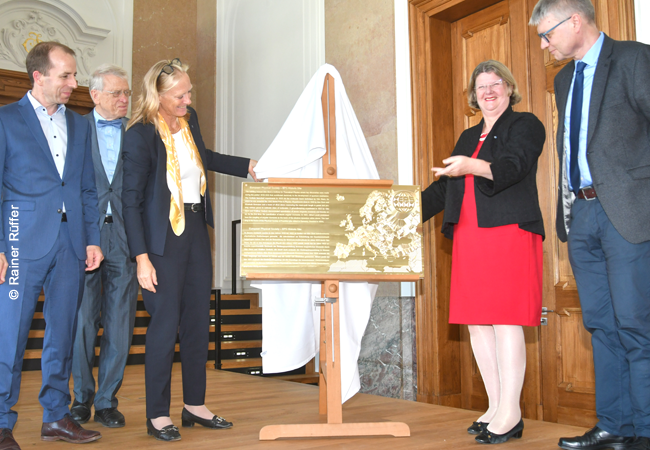
The 1920s were the golden age of quantum mechanics. Brilliant theoreticians and young, innovative thinkers poured the theory into its modern mathematical form. Their predictions inspired new experiments. At the Physics Institute of Frankfurt University headed by Max Born, physicists Otto Stern and Walter Gerlach made important contributions using a new experimental method. This will be commemorated by a “historic site” plaque that was unveiled Tuesday in a ceremony in the historic auditorium of the Jügelhaus, formerly the main Goethe University building on Bockenheim Campus. Once the Historical Monument Department has approved, the plaque will be mounted onto the former physics building at Robert-Mayer-Straße 2.
“Everyone is familiar with Goethe, but Nobel Prize winner Otto Stern is still largely unknown,“ comments University President Birgitta Wolff. “The university named its new auditorium complex on Riedberg Campus after Otto Stern a few years ago. I’m delighted that a Historic Site Plaque now marks the location where Otto Stern succeeded with his pioneering experiments.”
The “historic site” plaque is awarded by the European Physical Society to commemorate important discoveries in physics in laboratories, institutes or cities throughout Europe. The former Institute of Theoretical Physics building in Frankfurt is the fourth location in Germany to be distinguished with this plaque.
“The year 2019 presents a two-fold opportunity to remember the pioneer of quantum physics and Nobel Laureate Otto Stern,” explains physics professor Horst Schmidt-Böcking, who authored a biography of Otto Stern together with the historian Karin Reich. In 1919, Otto Stern developed the molecular beam method, for which he received the Nobel Prize for Physics in 1943. In the iconic Stern-Gerlach experiment, completed in February 1922, the reality of space quantization of angular momentum had been demonstrated. The momentum resolution achieved corresponded to an energy resolution of a micro electron volt. In 1922, together with Walther Gerlach in the iconic Stern-Gerlach experiment, the reality of space quantization of angular momentum was demonstrated, also proving the angular momentum quantization in atoms for the first time. “At the same time, we commemorate the 50th anniversary of Otto Stern’s death, who was forced to emigrate in 1933 because of his Jewish background,” remarks Schmidt-Böcking.
Otto Stern first settled in Pittsburgh and then Berkeley in 1945. In contrast to many other emigrants, he took every opportunity after the Second World War to meet with friends and colleagues at conferences in Europe. Horst Schmidt-Böcking has been in contact with Otto Stern’s descendants in the United States in recent years and invited them to visit their uncle’s old domain. Stern himself had no children.
“The Historic Site Plaque also commemorates other important discoveries made at the Physics Institute,” says Petra Rudolf, President of the European Physical Society. “In 1920 Max Born and Elisabeth Bormann first measured the free path of atoms in gases and the size of molecules. In 1921, the theoretician Alfred Landé postulated the coupling of angular momentum for the first time as the basis of intra-atomic electron dynamics.”
An international conference commemorating Otto Stern is taking place this week, as Wilhelm and Else Heraeus Seminar entitled “Otto Stern’s Molecular Beam Research and its Impact on Science”. Speakers include people who knew Stern such as his nephew Allen Templeton, scientific historians, and researchers whose experimental methods are based on the molecular beam method developed by Stern, such as magnetic resonance imaging, lasers and masers. The conference goes until 5th September.
Today, the historical building is home to the Physical Association of Frankfurt. Founded in 1824, it is the oldest one in Germany and was already in existence in 1914 when the university opened.








